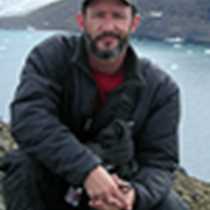Glacier Bay National Park
The northernmost point reached in our expedition, which began in Seattle, was achieved in one of the jewels of the national park system, Glacier Bay National Park. At just above 59° North and at 137° West, we had traveled about 1100 miles north and 900 miles west on our journey over the past 10 days.
This day began with the ship picking up our National Park Service Ranger at Bartlett Cove. She would spend the day interpreting the park history, both natural and cultural, along with the natural history staff. As the Sea Bird moved north we stopped at the Marble Islands for great looks at sea birds, including puffins. Steller sea lions could also be seen on the low rocks surrounding the islands. Later a slow down was done in Sandy Cove where sharp eyes found a feeding black bear on the shore. The ship was maneuvered very close to shore during which the bear hardly noticed our presence. Later in the morning more blacks bears and mountain goats could be seen low down as the snow this year is still very thick in the high country. As we ventured farther up bay the prize spotting went to our Expedition Leader, Bud who noticed a far off brown spot which turned out to be our catch of the day, a coastal brown bear foraging along shore. Another bear was seen swimming along shore nearby, once out of the water he or she turned over many large boulders in search of intertidal lunch. We progressed farther up bay to the northernmost point possible; the face of Marjorie (pictured) and Grand Pacific Glaciers. The ice was beautiful as it showed the twisted history of evaporated ocean water to snow, snow to ice, ice to glacier and now calved ice back to the sea.
The afternoon was spent traveling back to down bay to the entrance to the park where we were able to stretch our legs on shore before boarding the ship to continue our adventure.
The northernmost point reached in our expedition, which began in Seattle, was achieved in one of the jewels of the national park system, Glacier Bay National Park. At just above 59° North and at 137° West, we had traveled about 1100 miles north and 900 miles west on our journey over the past 10 days.
This day began with the ship picking up our National Park Service Ranger at Bartlett Cove. She would spend the day interpreting the park history, both natural and cultural, along with the natural history staff. As the Sea Bird moved north we stopped at the Marble Islands for great looks at sea birds, including puffins. Steller sea lions could also be seen on the low rocks surrounding the islands. Later a slow down was done in Sandy Cove where sharp eyes found a feeding black bear on the shore. The ship was maneuvered very close to shore during which the bear hardly noticed our presence. Later in the morning more blacks bears and mountain goats could be seen low down as the snow this year is still very thick in the high country. As we ventured farther up bay the prize spotting went to our Expedition Leader, Bud who noticed a far off brown spot which turned out to be our catch of the day, a coastal brown bear foraging along shore. Another bear was seen swimming along shore nearby, once out of the water he or she turned over many large boulders in search of intertidal lunch. We progressed farther up bay to the northernmost point possible; the face of Marjorie (pictured) and Grand Pacific Glaciers. The ice was beautiful as it showed the twisted history of evaporated ocean water to snow, snow to ice, ice to glacier and now calved ice back to the sea.
The afternoon was spent traveling back to down bay to the entrance to the park where we were able to stretch our legs on shore before boarding the ship to continue our adventure.




